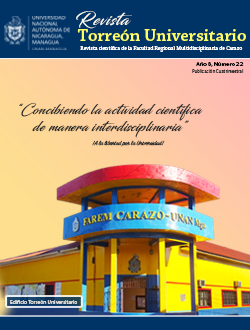Precipitation forecast model for the city of Managua using artificial neuronal networks in the context of environmental management
DOI:
https://doi.org/10.5377/torreon.v8i22.9028Keywords:
forecast model, teleconnections, artificial neural networks, climatic variablesAbstract
This paper proposes a numerical model of precipitation forecast for the city of Managua, based on data obtained by the weather stations: Managua, La Primavera and Casa Colorada (El Crucero), information provided by the Instituto Nacional de Estudios Territoriales (INETER), from the period corresponding to 1950-2014 and other climatic variables such as the Arctic Oscillation (AO), North Atlantic Oscillation (NAO), South Oscillation Index (SOI), Anomaly Index of the Monthly Average of the Temperature of the Surface of the Sea (SST) in the Tropical North Atlantic, region 5.5º N - 23.5º N and 57.5º W - 15º W (TNA) and the Oceanic Index of the Niño (ONI), through teleconnections. For the elaboration of the model, the selection and correlation of variables was carried out through statistical methods and to find the relationship between these variables, a multilayer perceptron was selected, which is an Artificial Neural Network whose architecture in this case is composed of; an input layer, a hidden layer and an output layer. This network has been trained through supervised learning through the backpropagation algorithm. This network will be used to predict future weather conditions in the city, which will help to make decisions about the management and planning of climate-sensitive activities to deal with possible natural disasters.
Downloads
898
PDF 417
HTML (Español (España)) 347
HTML 156
References
CEPAL, (Comisión Económica para América Latina y el Caribe). 2010. Nicaragua efectos del cambio climático sobre la agricultura. p. 72 p. Retomado de https://repositorio.cepal.org/bitstream/handle/11362/25925/1/lcmexl964.pdf
Naciones Unidas. Efectos del cambio climático en la costa de América Latina y el Caribe. Dinámicas, tendencias y variabilidad climática., diciembre de 2011. Retomado de https://www.cepal.org/es/publicaciones/3953-efectos-cambio-climatico-la-costa-america-latina-caribe-guia-metodologica
Chávez Espíritu, Tulio W. 2012. Análisis hidrológico ante impactos del cambio climático y cambios de uso del suelo en la cuenca del río Compasagua, Nicaragua. Tesis MSc. Turrialba, CR, CATIE. Retomado de http://repositorio.bibliotecaorton.catie.ac.cr/handle/11554/4471
Obregón, N.*, Fragala, F.* y Prada, L. F.** Seminario Internacional La Hidroinformática en la gestión integrada de los recursos hídricos. REDES NEURONALES ARTIFICIALES EN HIDROINFORMÁTICA. Pontificia Universidad Javeriana. Bogotá, Colombia. Universidad de los Andes. Bogotá, Colombia. Retomado de http://cinara.univalle.edu.co/archivos/pdf/61.pdf
Instituto Nicaragüense de Estudios Territoriales (INETER). Dirección general de Meteorología. Caracterización climática del Departamento de Managua. Dirección de aplicaciones de la meteorología Managua, 11 de diciembre 2008.Año: 2004 Editorial: Monografías del Instituto Nacional de Meteorología Páginas: 279 Ciudad: Madrid. Retomado de https://servmet.ineter.gob.ni//Meteorologia/climadenicaragua.php
Hilera, J.R., y V.J. Martínez. 2000. Redes neuronales artificiales. Fundamentos, modelos y aplicaciones. 390 p. Editorial Alfaomega Ra-Ma, Madrid, España. https://www.academia.edu/39737539/REDES_NEURONALES_ARTIFICIALES_FUNDAMENTOS_MODELOS_Y_APLICACIONES
Ovando, Gustavo, Bocco, Mónica, & Sayago, Silvina. 2005. REDES NEURONALES PARA MODELAR PREDICCIÓN DE HELADAS. Agricultura Técnica, 65(1), 65-73.
Retomado de http://www.scielo.cl/scielo.php?script=sci_arttext&pid=S0365-28072005000100007&lng=es&tlng=es. 10.4067/S0365-28072005000100007.
Ribalaygua, J., De Loma-Ossorio, E., Córdoba, M., Torres, L., Lahoz, C., Arias, A. y Caicedo, A. MOPT. 1992. Guías para la elaboración de estudios del medio físico (contenido y metodología). Ministerio de obras públicas, transporte y medio ambiente. España (2011).
Milán, J. 2011. Apuntes sobre el cambio climático en Nicaragua. Managua, Nicaragua. Retomado de http://www.cambioclimatico.ineter.gob.ni/bibliografia/Educacion%20y%20Cambio%20Clim%C3%A1tico/Apuntes%20sobre%20Cambio%20Climatico%20en%20Nicaragua1.pdf
IPCC (Intergovernmental Panel on Climate Change). 2007. Cambio climático 2007: informe de síntesis. Contribución de los grupos de trabajo I, II y III al cuarto informe de evaluación del Grupo Intergubernamental de Expertos sobre el Cambio Climático, Ginebra, pág. 104. Retomado de https://www.ipcc.ch/site/assets/uploads/2018/02/ar4_syr_sp.pdf
INETER (Instituto Nacional de Estudios Territoriales). 2005. Normas históricas. “Comportamiento de las temperaturas medias anual en periodo 1971 al 2000”. Managua, Nicaragua. Retomado de https://servmet.ineter.gob.ni//Meteorologia/climadenicaragua.php
Freeman, J.A., and D.M. Sapera. 1991. Neural networks: algorithms, applications and programming techniques (Computation and Neural Systems Series) 401 p. Addison-Wesley Pub. Co., Reading, Massachusetts, USA. Retomado de https://pdfs.semanticscholar.org/3847/897e4a15d1078499466087ea7885061c6465.pdf
Downloads
Published
How to Cite
Issue
Section
License
Los autores que publican en esta revista están de acuerdo con los siguientes términos.
- El autor o los autores de los artículos, ensayos o investigaciones conceden a la Universidad Nacional Autónoma de Nicaragua, Managua (UNAN-Managua) los derechos de edición (copyright) del trabajo enviado, por consiguiente la Universidad cuenta con el derecho exclusivo para publicar el artículo durante el periodo completo de los derechos de autor.
- Estos derechos de autor/ autores autorizan a la Revista Torreón Universitario y a la Universidad editar y divulgar/publicar el artículo en dicha Revista, incluyendo reproducción impresa y electrónica, el almacenamiento, recuperación y cualquier otro tipo de publicación, y fuentes de información secundaria como servicios de resúmenes y bases de datos, así mismo la facultan a proteger el artículo contra el uso no autorizado para su difusión por medios impresos o electrónicos (PDF, HTML, EPUB, XML u otros).
Licencia para el uso del contenido
La revista hace uso de la Licencia Creative Commons Atribución-NoComercial-SinDerivar 4.0 Internacional.
Bajo esta declaración:

Este revista está sujeta a una licencia de Creative Commons Reconocimiento-NoComercial-SinObraDerivada 4.0 Internacional. Puede ser copiada, distribuida y transmitida públicamente siempre y cuando se cite al autor y la fuente (Revista Torreón Universitario), no debe modificarse ni utilizarse con ningún fin comercial. La licencia completa se puede consultar en http://creativecommons.org/licenses/by-nc-nd/4.0/.



